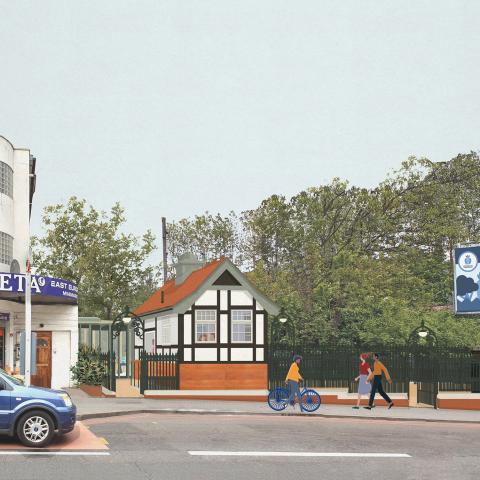The piloting of a new ‘Community Wealth Building Lease’ at the Grade II listed Bruce Grove Public Conveniences in Haringey is an innovative example of how councils can maximise the public benefits of their built assets through lease arrangements which build and retain wealth in the local community.
Powers used
- Asset management
The challenge
The former public conveniences building has been vacant for decades and sits in a highly constrained location adjoining the railway line at a key junction with Tottenham High Road. Viability of redevelopment and re-occupation is challenging, particularly due to the listed nature of the building. The project is supported by the Greater London Authority’s Good Growth Fund and Historic England’s High Streets Heritage Action Zone funding to unlock viability and secure the building’s future.
With the dramatic economic impact of COVID-19 across Haringey, there has been a significant impact on the hospitality industry alongside an anticipated rise of unemployment levels.
The solution
Haringey Council are in the process of refurbishing and extending the building, a new community café designed to benefit local residents and businesses. The council’s key priorities as part of its ‘Good Economy Recovery Plan’ include supporting businesses through recovery and into renewal and supporting residents into work and training. The Bruce Grove Public Conveniences site provides the opportunity for a local food and beverage operator with strong social value credentials to deliver new jobs, training and spend in the local supply chain.
Working closely with the council, local campaign group ‘The Last Elm’, DK-CM Architects and heritage consultant Rob Bevan have worked to capture and protect the significance of the small building, both above and below ground, to ensure it comes off the Historic England ‘at risk’ register.
The design includes remodeling of the basement and a contemporary extension to provide a new garden room to the rear. The renovation of the new cafe is funded by Haringey Council, the Greater London Authority’s Good Growth Fund and Historic England’s ‘High Street Heritage Action Zone’ funding.
The restoration, which has received planning permission, gives the opportunity for the council to pilot the new Community Wealth Building Lease. The Lease will ascribe a monetary value to Social Value outcomes and will seek to incentivise performance and manage the resource required to monitor and enforce performance by offering discounts for performing tenants based on the monetary value of what is delivered (rather than penalising non-performance).
Social value indicators will include:
- Number of people from Tottenham Full Time Employee (FTE) employed on contract for at least six months
- Number of employees (FTE) taken on who are long-term unemployed
- Number of employees (FTE) taken on who are Not in Education, Employment, or Training (NEET)
- Number of employees (FTE) taken on who are rehabilitating young offenders (18-24 year olds)
- Number of jobs (FTE) created for people with disabilities, especially those with learning difficulties or suffering from mental health issues
- Number of weeks spent on meaningful work placements or pre-employment course; 1-6 weeks student placements (unpaid)
- Meaningful work placements that pay Minimum or National Living wage according to eligibility 6 weeks or more (internships or apprenticeship)
- Total amount (£) spent in Haringey supply chain/annum or with local SMEs
From Haringey Council’s perspective, the concept of social value is very closely aligned with the emerging priorities of its Borough Plan, most notably that of building and retaining wealth within the local community. Lessons learned from this pilot project will help inform future council policy and operations regarding how it uses its property portfolio.

